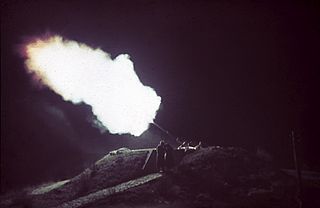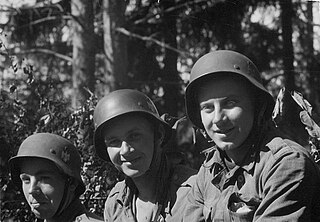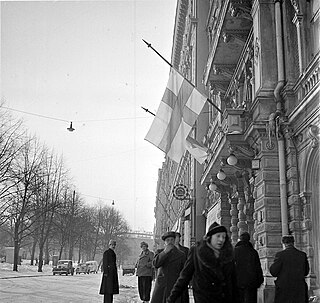 W
WFinland participated in the Second World War initially in a defensive war against the Soviet Union, followed by another battle against the Soviet Union acting in concert with Nazi Germany and then finally fighting alongside the Allies against Nazi Germany.
 W
WHelsinki, the capital of Finland, was bombed repeatedly during World War II. Between 1939 and 1944, Finland was subjected to a number of bombing campaigns by the Soviet Union. The largest were three raids in February 1944, which have been called The Great Raids Against Helsinki.
 W
WThe Erna long-range reconnaissance group was a Finnish Army unit of Estonian volunteers, that fulfilled reconnaissance duties in Estonia behind Red Army lines during World War II. The unit was formed by Finnish military intelligence with the assistance of German military intelligence for reconnaissance operations.
 W
WInfantry Regiment 200 or soomepoisid was a unit in the Finnish army during World War II made up mostly of Estonian volunteers, who preferred to fight against the Soviet Union in the ranks of the Finnish army instead of the armed forces of Germany.
 W
WThe Finnish Volunteer Battalion of the Waffen-SS was a motorized infantry battalion of the German Waffen-SS during World War II. It was formed from Finnish volunteers and fought on the Eastern Front as part of the SS Division Wiking. The unit was disbanded in mid-1943 as the two-year commitment of the volunteers had expired and the Finnish government was unwilling to allow more men to volunteer. About 1,400 men served in the battalion throughout its existence.
 W
WThe Interim Peace was a short period in the history of Finland during the Second World War. The term is used for the time between the Winter War and the Continuation War, lasting a little over 15 months, from 13 March 1940 to 24 June 1941. The Moscow Peace Treaty was signed by Finland and the Soviet Union on 12 March 1940 and it ended the 105-day Winter War.
 W
WThe Liberation of Finnmark was a military operation, lasting from 23 October 1944 until 26 April 1945, in which Soviet and Norwegian forces wrested away control of Finnmark, the northernmost county of Norway, from Germany. It started with a Soviet offensive that liberated Kirkenes.
 W
WLotta Svärd was a Finnish voluntary auxiliary paramilitary organisation for women. Formed originally in 1918, it had a large membership undertaking volunteer social work in the 1920s and 1930s. It was formed to support the White Guard. During the Second World War, it mobilized to replace men conscripted into the army. It served in hospitals, at air raid warning positions, and other auxiliary tasks in close cooperation with the army. The women were officially unarmed except for an antiaircraft battery in 1944. Virtanen argues that, their "accountability to the nation took a masculine and military form in public, but had a private, feminine side to it including features like caring, helping and loving." The organisation was suppressed by the government after the war.
 W
WThe occupation of the Baltic states involved the military occupation of the three Baltic states—Estonia, Latvia and Lithuania—by the Soviet Union under the auspices of the 1939 Molotov–Ribbentrop Pact in June 1940. They were then annexed into the Soviet Union as constituent republics in August 1940, though most Western powers and nations never recognised their incorporation. On 22 June 1941, Nazi Germany attacked the Soviet Union and within weeks occupied the Baltic territories. In July 1941, the Third Reich incorporated the Baltic territory into its Reichskommissariat Ostland. As a result of the Red Army's Baltic Offensive of 1944, the Soviet Union recaptured most of the Baltic states and trapped the remaining German forces in the Courland pocket until their formal surrender in May 1945.
 W
WThe matter of German troop transfer through Finland and Sweden during World War II was one of the more controversial aspects of modern Nordic history beside Finland's co-belligerence with Nazi Germany in the Continuation War, and the export of Swedish iron ore during World War II.